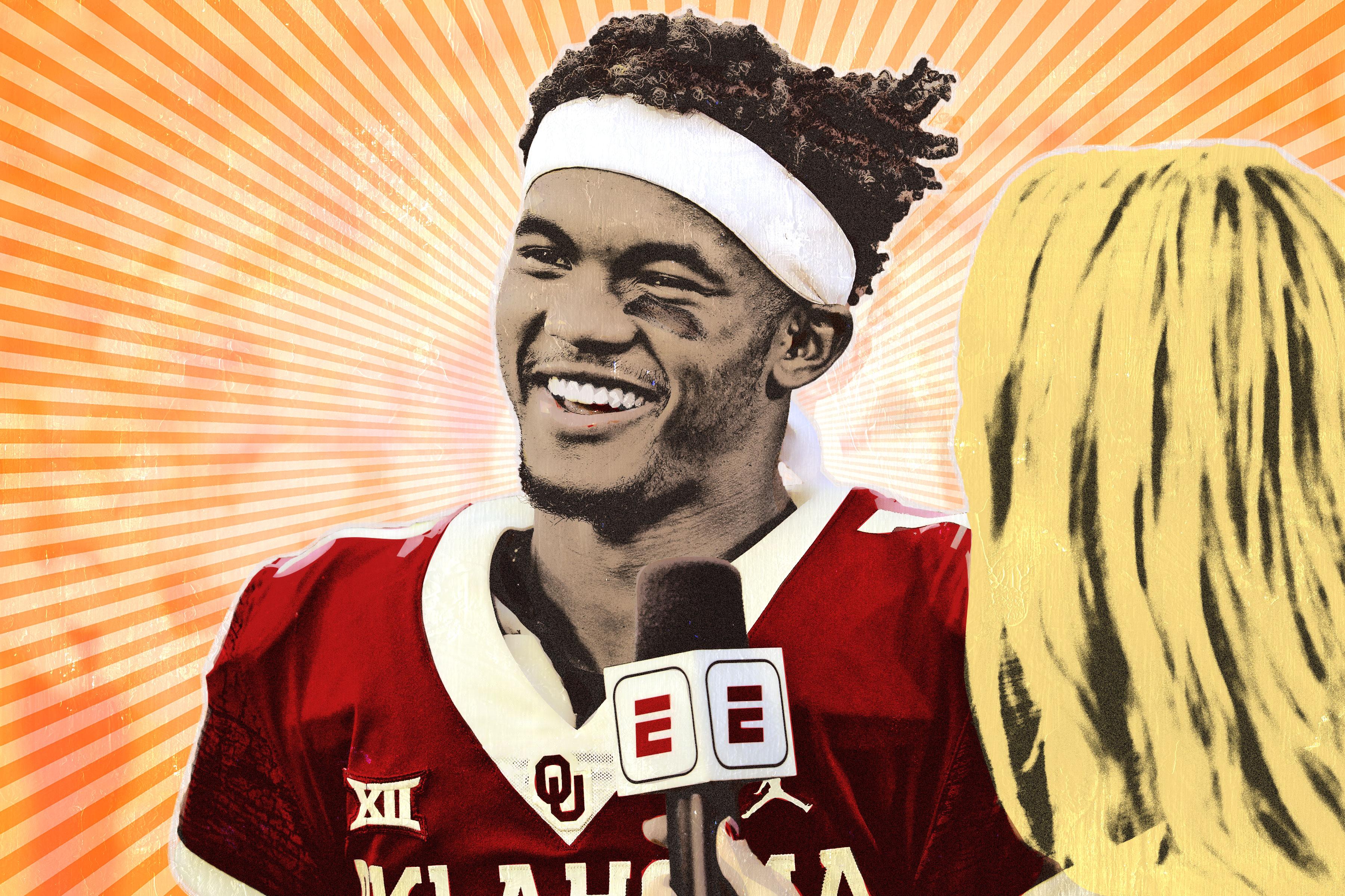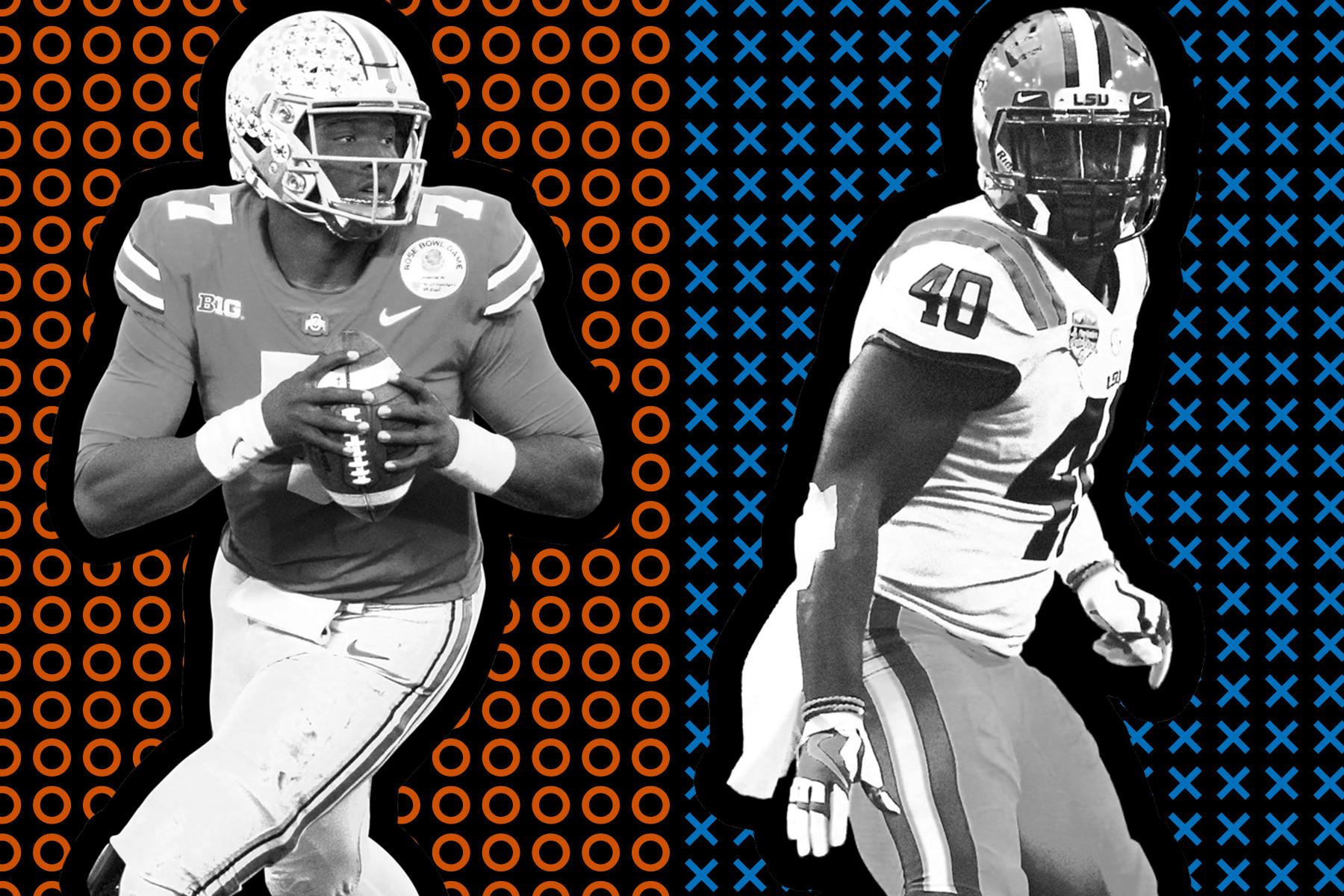
One feature of our media age is that NBA players are the perfect sports content machines. Reporters like them because they’re great at basketball. But we also value a Kyrie Irving or a Kevin Durant because their careers contain hypotheticals, what-ifs, “decisions” that—or so we write in our column—will change the course of the league. The NFL will soon have its own such content machine. His name is Kyler Murray.
It’s no accident that the simple act of measuring Murray’s height at Thursday’s NFL combine has become a content storm. Murray has been at the center of these things since he was a teenager, and nearly all of them have an NBA-like, end-times feel. The funny thing is, Murray is mostly a reluctant participant. “He has drawn so much attention,” said The Athletic’s Jason Kersey, who covered Murray at Oklahoma. “Yet he really doesn’t like it.”
Growing up, Murray had a profile that was more like a basketball prospect than a football prospect. He was famous when he was 15 years old. “No high school football player in Texas has had more ink spilled about them than Kyler Murray,” said Greg Tepper, the managing editor of Dave Campbell’s Texas Football magazine. Murray went to Allen High School, a 5,000-student behemoth north of Dallas that hovers over Texas high school football like the New York Yankees. As a sophomore, Murray replaced the team’s starting quarterback and led Allen to a state championship.
It was the first time Murray found himself filling a content hole. Usually, prep reporters get only one offseason to write about a future college and NFL star. As Tepper explained, “You have the entire Texas high school media mafia looking around saying, ‘Look at this kid—and we get two years of him.’”
Murray went 42-0 in high school. The 2013 state championship game he played in drew 54,347 fans at AT&T Stadium, the largest crowd ever to see a high school game in Texas. A fellow recruit told The Athletic that hanging out with Murray was like hanging out with the quarterback of the Cowboys.
Long before NBA free agency became a mega-event, college football recruiting was like The Decision with 1,000 different Wojes. In January 2015, the smart money was that Murray would honor his commitment to play for Texas A&M, the same school where his father, Kevin, had once played quarterback.
A few weeks before signing day, Murray made a secret visit to the University of Texas and, along with a fellow recruit, tweeted a picture of a Longhorns jersey. It doesn’t sound like much. But the resulting fury—fan bases losing their minds; a journalist-on-journalist throwdown over whose inside dope was right—was a lot like the aftermath of a great NBA bombshell. The Athletic wrote a longform story about what it called a “masterful troll.” Murray signed with Texas A&M.
For most football players, the moment they choose their college is the single instant they command that kind of attention. Murray had two more such moments. In December 2015, he transferred from Texas A&M to Oklahoma, leading some ex-teammates to light him up on Twitter, and ultimately led to the end of coach Kevin Sumlin’s regime. It was a handy offseason story in a year when the Aggies went 8-5.
Three years later, after winning the Heisman at Oklahoma, Murray faced yet another high-profile “decision.” Would he go to the NFL or put on a cape and play for the Oakland A’s, the team that drafted him no. 9 overall?
Unlike his recruitment, Murray did anything but revel in the attention. On his Super Bowl week media tour, he submitted to interviews despite the fact that he couldn’t give the one answer everyone wanted. When Dan Patrick gently asked whether Murray was going to A’s spring training or having a pro day for NFL scouts, Murray would mumble an answer or look at his dad offstage for guidance. He was silent when asked questions like, “How’s that NFL football feel?”
“You know these microphones are on right now?” Patrick said at one point.
Murray’s eventual announcement was divided into two discrete content opportunities. On January 14, Murray said he was entering the NFL draft—but not ruling out baseball. A month later, Murray announced he was “firmly and fully committing my life” to football.
That news produced more what-if stories. Would new Cardinals coach Kliff Kingsbury, who once said he’d take Murray no. 1 overall, draft him and toss aside last year’s first-rounder, Josh Rosen? Would Murray be one of the fastest players in the history of the NFL combine? Would Murray do anything at the combine except get measured? While meeting the Dallas media this month, Murray said he wasn’t sure he wanted go through the drills.
“I’m not sure I’m working out” is a classic nonstory. But by this point, Murray’s aura was so bright that even conservative website The Daily Caller aggregated the news.
Murray occasionally makes his own news, like when he tweets about the Longhorns or reboots Bo Jackson’s bat-and-shoulder pads photo. But most of his interactions with reporters are polite, brief, and fairly opaque. “He’s a fascinating person,” Kersey said. “My feeling is that nobody or at least the public doesn’t really know him the way you know other stars because he doesn’t like that attention.”
Murray’s obvious “comp” is Baker Mayfield, the Heisman-winning quarterback he replaced at Oklahoma. As media entities, they are completely different. “If you told Baker he was too short to play quarterback, he would want to fight you,” Tepper said. “Kyler Murray would kind of shrug into a microphone.”
“Baker sort of let you in,” said Tulsa World columnist Guerin Emig. “Kyler won’t do that. That’s fine. I don’t see that as a negative. But a lot of the time we’re all sort of left to wonder what’s going on inside his head.”
As Emig noted in a column this week, when Mayfield returned to Oklahoma for a predraft basketball game, he pumped up the crowd, trolled the Longhorns, and took a victory lap on ESPN. Last week, at a similar event, Murray shook hands and talked to local reporters for a few minutes.
Last season, Kersey said, the Sooners press corps was told after a few practices that Murray had only five minutes to answer questions—something Kersey can’t remember happening with any previous Oklahoma quarterback.
Last month, after Murray committed to playing football, the Fort Worth Star-Telegram’s Mac Engel joked on Twitter that the Bill Polian types would look at a dazzling mobile quarterback like Murray and see a cornerback. Murray blocked Engel. When Engel met him later, Murray said, “You are the only person that said that. I don’t know how you could possibly make that up; I don’t know if you watched football or anything, or what happened this season. I have never heard that.”
As ESPN’s Jeff Passan noted, when you watch Murray you feel a sense of control, a game plan, guiding his every move. Murray’s most important adviser is his father, who played minor league baseball, then switched to football, and wound up going undrafted.
For the people who cover college football, the Quarterback Dad is usually a beloved archetype. He’s the guy who feeds reporters gossip about the depth chart. While Murray was at Oklahoma, Kevin Murray was as reluctant to talk as his son. “I don’t know that anyone on the OU beat talked to Kevin,” Kersey said. “I think a lot of us tried.”
“Because Kyler is so media-shy,” Tepper said, “a lot of the attention is speculation.” In college football, Murray became a mini-version of James Harden, where scrutiny of social media and video stood in for the revealing interview. After Oklahoma lost a game to Texas last October, reporters noticed that Murray seemed pissed when Longhorns quarterback Sam Ehlinger came up to talk to him after the game. When asked if he respected Ehlinger, Murray laughed and said, “I got no comment on that.” His nonanswer became a story.
Murray may not love revealing himself to the media. But the media loves Murray. Like any good athlete-subject, his career path has activated certain content trip wires. In Texas, his entanglement with the Sooners, Aggies, and Longhorns is the kind of thing that can keep the Rivals network afloat for 100 years. Murray turning down a $4.6 million signing bonus from the A’s highlights baseball’s sagging fortunes versus the NFL and NBA. Last month, an SB Nation A’s writer who called Murray a “brat” was let go after she wrote, “I wont care a bit when you suck or [are] critically injured in your rookie NFL season.”
If you told Baker he was too short to play quarterback, he would want to fight you. Kyler Murray would kind of shrug into a microphone.Greg Tepper, managing editor of Dave Campbell’s Texas Football magazine
The window between the Super Bowl and the NFL draft is filled with articles that try to guess which college players have the traits to succeed as pros. At some point, the articles become a referendum on what team-building ought to look like in 2019. Murray is perfect for this period; he’s a think piece in cleats.
So far, Murray has been a peg for stories about whether quarterbacks from college offenses like Oklahoma’s can succeed in the NFL. He’s a peg for stories about whether mobile quarterbacks can succeed (though 89 percent of Murray’s throws last season came from inside the pocket, as Pro Football Focus notes). He’s a peg for stories about whether short quarterbacks can succeed—with the inevitable comps to Drew Brees, Russell Wilson, and Mayfield.
A few weeks ago, I interviewed Mel Kiper Jr. for a story about the combine. Kiper was skeptical about whether watching players perform drills is useful or interesting, even for a draft guru.
Minutes later, Murray announced he was committing to football. My phone rang. It was Kiper calling back. This time, his Micro Machines Man voice had the ring of genuine wonder. The combine was suddenly fascinating, Kiper declared, and this year’s edition would be “the most anticipated combine probably in the history of the combine.” Kyler Murray has that effect on people.


